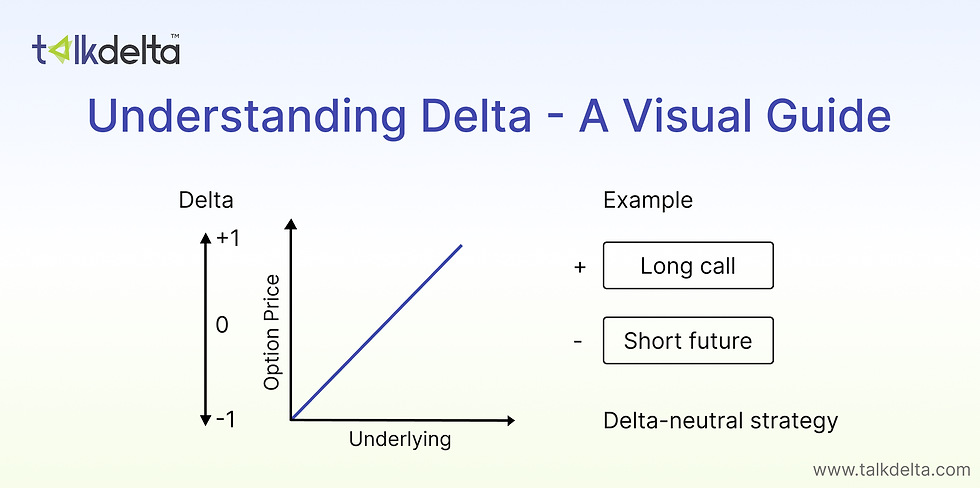Underlying Asset
- jayashreelankealgo
- Aug 16, 2021
- 2 min read
Updated: Oct 27, 2021

The underlying asset is defined as the asset on which the financial instruments such as derivatives are based and the value of the underlying asset is indirectly or directly related to the contracts of the derivatives. Knowing the value of an underlying asset helps traders determine the appropriate action (buy, sell or hold) with their derivative. Investors use options and the concept of underlying assets for two primary reasons, to speculate and to hedge risk. When you purchase options to speculate on future stock price movements you are limiting your downside risk yet your upside earnings potential is unlimited.
Types of Underlying Assets
Commodities
Grains and oilseeds (wheat, corn, soybeans, and canola)
Livestock and meat (pork bellies, hogs, live cattle, and feeder cattle)
Forest, fiber, and food (lumber, cotton, orange juice, sugar, cocoa, and coffee)
Precious and industrial metals (gold, silver, platinum, copper, and aluminum)
Energy products (crude oil, heating oil, gasoline, natural gas, and propane)
Financial Assets
Equities
Interest Rates
Government Bonds.
Currencies
Types of Asset Classes
Securities that behave similarly in terms of value appreciation and are subject to the same laws and regulations are grouped to form asset classes.
Equity
People invest in equity generally to fulfill their long term goals.
Example: Direct Stocks, Equity oriented MFS, National Pension System (NPS), Equity ULIPS, etc.
Equity characteristics:
Average to understand
Highly Liquid
Above inflation returns
Volatile returns
Fixed income
Fixed income investments are for short term goal.
Example: PPF, EPF, VPF,Debt Funds,Bonds(govt., corporate),Post office Schemes, Endowment policies, etc.
Fixed-income assets characteristics:
Easy to understand
High Liquidity
Near inflation returns
Low volatility in returns
Cash
Cash asset is generally used as an emergency fund.
Example: Liquid Funds, FDS, Savings account balance
Cash assets characteristics:
Simple to understand
Very high liquidity
Below inflation returns
No volatility
Real estate
This asset investment is generally a long term investment.
Example: Residential space, Commercial space, Land, etc.
Real estate assets class characteristics:
Complex to understand
Very Low liquidity
Above Inflation returns
High volatility
Gold(Commodity)
As gold is a commodity asset it is more suitable for trading.
Gold assets Characteristics:
Complex to understand
High Liquidity
Near Inflation returns
High volatility
Before investing in asset classes one should keep in mind following things.
Risk return associated with the particular asset class.
The liquidity it offers.
Complexity associated with understanding that particular asset.
Need to invest in a particular asset class.



Hempdelics is one of the best dispensaries in the United States that sells legal Psychedelic Products ! Whether you’re looking for a great trip or you’re ready to dive deeper into unlocking your mind, Hempdelics got you covered. We are Best in psychedelic mushrooms and microdosing mushrooms!
<a href="https://hempdelics.com/product/oneup-bars/" rel="dofollow">OneUp Bars</a>
<a href="https://hempdelics.com/product/5-meo-dmt/" rel="dofollow">5-MeO-DMT</a>
<a href="https://hempdelics.com/product/buy-ayahuasca/" rel="dofollow">Buy Ayahuasca</a>
<a href="https://hempdelics.com/product/psilocybin-capsules/" rel="dofollow">Psilocybin Capsules</a>
<a href="https://hempdelics.com/product/lsd-gel-tabs/" rel="dofollow">LSD Gel Tabs</a>
<a href="https://hempdelics.com/product/liquid-lsd/" rel="dofollow">Liquid LSD</a>
<a href="https://hempdelics.com/product/lsd-blotters/" rel="dofollow">LSD Blotters</a>
<a href="https://hempdelics.com/product/mdma-pills/" rel="dofollow">MDMA Pills</a>
<a href="https://hempdelics.com/product/lsd-gummies/" rel="dofollow">LSD Gummies</a>
<a href="https://hempdelics.com/product/buy-golden-teacher-cubensis/" rel="dofollow">Buy Golden Teacher Cubensis</a>
<a href="https://hempdelics.com/product/magic-mushroom-grow-kits/" rel="dofollow">Magic Mushroom Grow Kits</a>
<a href="https://hempdelics.com/product/arenal-volcano-cubensis/" rel="dofollow">Arenal Volcano Cubensis</a>
<a href="https://hempdelics.com/product/blue-meanies-cubensis/" rel="dofollow">Blue Meanies Cubensis</a>
<a href="https://hempdelics.com/product/penis-envy-magic-mushroom/" rel="dofollow">Penis Envy Magic Mushroom</a>
<a href="https://hempdelics.com/product/amazonian-cubensis/" rel="dofollow">Amazonian Cubensis</a>
<a href="https://hempdelics.com/product/b-cubensis/" rel="dofollow">B+ Cubensis</a>
<a…
Kaiser OTC benefits provide members with discounts on over-the-counter medications, vitamins, and health essentials, promoting better health management and cost-effective wellness solutions.
Obituaries near me help you find recent death notices, providing information about funeral services, memorials, and tributes for loved ones in your area.
is traveluro legit? Many users have had mixed experiences with the platform, so it's important to read reviews and verify deals before booking.